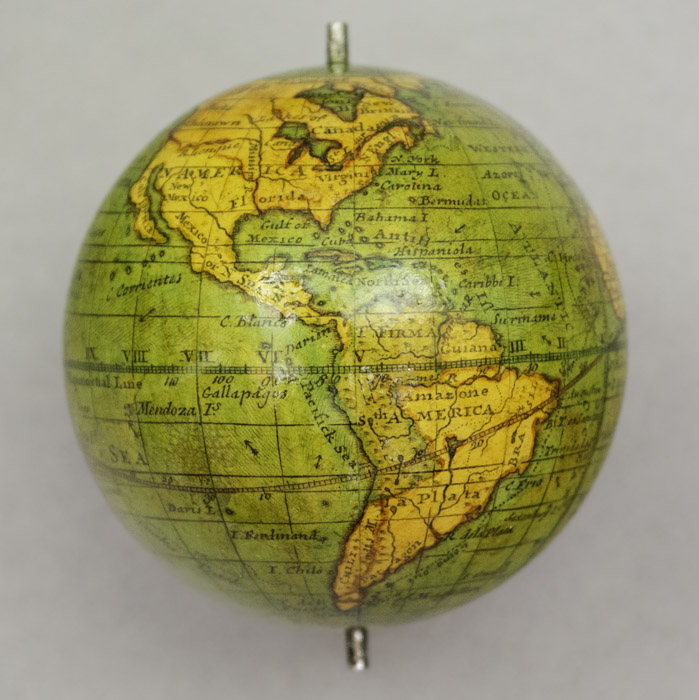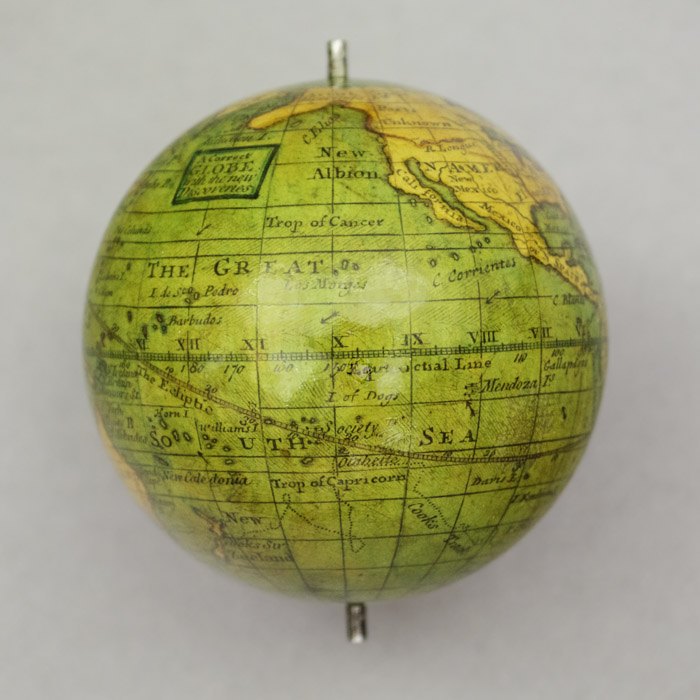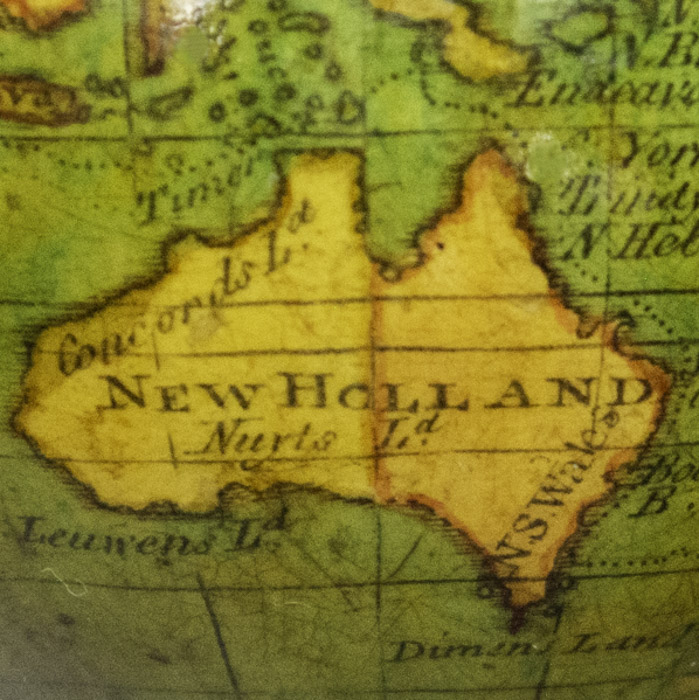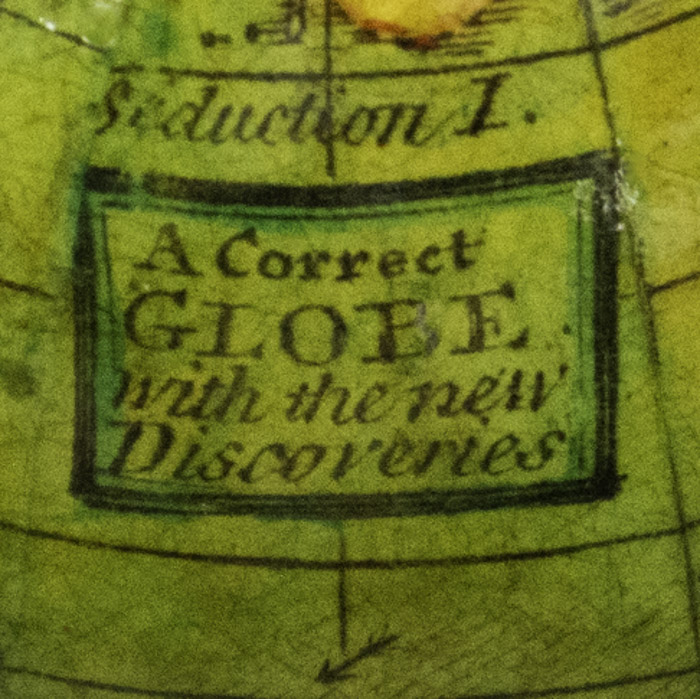Description
The globe is colored in tones of pink, yellow, and green with larger geographic regions outlined in red. Oceans are colored green. The United States has simple cartography and only a few places names, principal among them east of the Mississippi River include N. Engl., New York, Mary L. (i.e. Maryland), Carolina, Virginia (encompassing most of the mid-section), and Florida (extending fairly far west). The region west of the Mississippi River is labeled New Mexico, New Albion, California (shown as a peninsula), and “Parts Unknown” in the Pacific Northwest. On the celestial globe, the constellations are named and drawn as classical mythological figures and as illustrations of scientific instruments on a green ground overall, but otherwise uncolored. The stars are represented by different symbols corresponding to a key in the northern hemisphere, according to five orders of magnitude (or possibly six, depending on deciphering the small printed numbers).
Pocket globes manufactured in London in the 18th and 19th centuries were often made using copper plates that were revised, updated, and/or relabeled by successive globe makers, engravers or sellers. According to globe and map scholar Elly Dekker, the antecedents of the offered globe can be traced back to a 1719 pocket globe by Herman Moll, bearing the cartouche “A Correct Globe with ye Trade winds by H. Moll.” Both the 1719 Moll globe and the offered globe bear the name “A Correct Globe” and are discussed in Dekker’s book Globes at Greenwich. According to Dekker, the globes are quite similar to each other, but in the later example, as compared with the earlier 1719 globe, Captain Cook’s 1760 voyage was added, the 17th-century voyages of the English explorer and pirate William Dampier (1651-1715) were removed (though traces are still visible), and some other geographic information was amended or changed. The celestial gores as originally issued by Moll were basically left unchanged on the later example, except that the cartouche in the earlier Moll globe “A Correct Globe with ye New Constellations of Mr. Hevelius, 1719” was amended on the later one to specify that it was updated with the discoveries of Dr. Halley and the date 1719 was removed. The later cartouche information is a reference to English astronomer Edmond Halley (1656-1742) and the former refers to Polish astronomer Johannes Hevelius (1611-1687).
Dekker suggests that the later “Correct Globe” as offered here was issued c. 1775. Nonetheless, another example of a later “Correct Globe,” but with a cartouche overlabel of W. & S. Jones, 30 Holborn, London — a renowned and prolific scientific instrument makers and dealers of globes — is known and was sold by George Glazer Gallery. Inasmuch as Jones was active from about 1792 to 1830, we posit that it could be that the revised and reissued Correct Globe could be of a date later than 1775, perhaps sometime in the last quarter of the 18th century or into the early 19th century. Regardless, the publisher of the revised and reissued later “Correct Globe” remains unknown.
W. & S. Jones was an optical instrument maker, bookseller, printer, and among the greatest scientific instrument makers in London in the early 19th century, operating from 1792 to 1830. The firm was founded by brothers William (1763-1831) and Samuel (1769-1859), as successors to the firm of their father John Jones, also an optical instrument maker and bookseller. They sold various globes with their overlabel including ones by the London globemaker W. & T.M. Bardin and also a “Correct Globe” pocket globe in a celestial case by an unknown globemaker. The heyday of the pocket globe was Georgian period England, from the early 18th century to the late 19th century, where they were mainly made as specialty items for English aristocrats interested in geography and astronomy. Read more about the history and development of pocket globes.
Rectangular cartouche, terrestrial globe: A Correct/ GLOBE/ with the new/ Discoveries.
Trapezoidal cartouche, celestial globe: A Correct Globe with ye New Cons:/ tellations of Dr./ Halley & c.
Condition: Terrestrial globe and celestial concave globe very good, recently professionally restored, with the usual remaining expected light toning, wear, handling, and with restorations to minor scattered abrasions. Overall the terrestrial globe retains a golden antique tone with bright colors. Case good, slightly warped, recently professionally restored to close a few small cracks, now with a small remaining irregular gap as closed and lacking 1 of 3 hooks, and 1 of 3 eyelets.
References:
Clifton, Gloria C. Directory of British Scientific Instrument Makers, 1550-1851. pp. 154-55.
Dekker, Elly, et al. Globes at Greenwich: A Catalogue of the Globes and Armillary Spheres in the National Maritime Museum, Greenwich. London: Oxford University Press and the National Maritime Museum, 1999. pp. 129, 136, 417-418, 529-530.


























